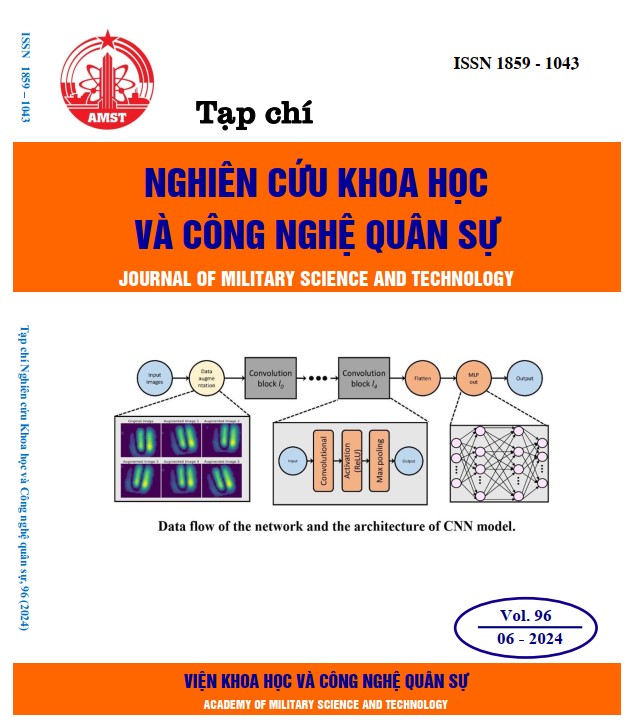Application of CNN deep learning model and CFAR filtering technique for RF-based drone signal classification in noisy conditions
489 viewsDOI:
https://doi.org/10.54939/1859-1043.j.mst.96.2024.30-40Keywords:
Drone classification; Convolutional neural networks; Spectrogram; Constant false alarm rate CFAR.Abstract
Currently, the use of small scale unmanned aerial vehicles, commonly known as drones, has increased due to the growing demand for remote interaction, contactless operations, and advanced technology. However, alongside the rising demand for drones across various sectors, their misuse for nefarious purposes has also escalated. Therefore, there is a need for drone monitoring systems to detect unauthorized drone usage. In this work, we propose a solution based on the radio frequency (RF) signature of drones. The data used in the research are control signals from 17 types of publicly disclosed drones. The proposed method addresses the issue of drone classification based on RF signatures; it maintains classification accuracy when the signal-to-noise ratio (SNR) decreases due to the presence of significant noise. In the experiments, we expanded the control signal data by adding white Gaussian noise to alter the SNR from −15 dB to 15 dB with 5 dB increments. Power spectral portraits with threshold values were applied to create training images for the convolutional neural network (CNN). The proposed model achieved 96% accuracy at an SNR of −15 dB and 99.82% accuracy in the high SNR region. From these results, we have confirmed that the proposed method not only has good classification capabilities but also high noise immunity.
References
[4]. D. Krijnen, C. Dekker, “AR Drone 2.0 with Subsumption Architecture”, In Artificial intelligence research seminar, (2014).
[5]. R.J. Bachmann, F.J. Boria, R. Vaidyanathan, P.G. Ifju, R.D. Quinn, “A biologically inspired micro-vehicle capable of aerial and terrestrial locomotion”, Mach. Theory 44, 513–526, (2009). DOI: https://doi.org/10.1016/j.mechmachtheory.2008.08.008
[6]. M. Hassanalian, A. Abdelkefi, M. Wei, S. Ziaei-Rad, “A novel methodology for wing sizing of bio-inspired flapping wing micro air vehicles: theory and prototype”, Acta Mech. (2016). http://dx.doi.org/10.1007/s00707-016-1757-4v. DOI: https://doi.org/10.1007/s00707-016-1757-4
[7]. D. Floreano, R.J. Wood, “Science, technology and the future of small autonomous drones”, Nature 521 (7553), 460–466, (2015). DOI: https://doi.org/10.1038/nature14542
[8]. P. Cisar, R. Pinter, S. M. Cisar, and M. Gligorijevic, “Principles of antidrone defense,” in Proc. 11th IEEE Int. Conf. Cognit. Infocommunications (CogInfoCom), pp. 000019–000026, (2020). DOI: https://doi.org/10.1109/CogInfoCom50765.2020.9237841
[9]. S. Al-Emadi, A. Al-Ali, and A. Al-Ali, “Audio-based drone detection and identification using deep learning techniques with dataset enhancement through generative adversarial networks,” Sensors, vol. 21, no. 15, p. 4953, (2021). DOI: https://doi.org/10.3390/s21154953
[10]. G. Ding, Q. Wu, L. Zhang, Y. Lin, T. A. Tsiftsis, and Y.-D. Yao, “An amateur drone surveillance system based on the cognitive Internet of Things,” IEEE Commun. Mag., vol. 56, no. 1, pp. 29–35, (2018). DOI: https://doi.org/10.1109/MCOM.2017.1700452
[11]. M. Ezuma, F. Erden, C. K. Anjinappa, O. Ozdemir, and I. Guvenc, “MicroUAV detection and classification from RF fingerprints using machine learning techniques,” in Proc. IEEE Aerosp. Conf., pp. 1–13, (2019). DOI: https://doi.org/10.1109/AERO.2019.8741970
[12]. M. Ezuma, F. Erden, C. K. Anjinappa, O. Ozdemir, and I. Guvenc, “Drone remote controller RF signal dataset,” Tech. Rep., (2020), doi: 10.21227/ss99-8d56.
[13]. M. Ezuma, F. Erden, C. K. Anjinappa, O. Ozdemir, and I. Guvenc, “Detection and classification of UAVs using RF fingerprints in the presence of Wi-Fi and Bluetooth interference,” IEEE Open J. Commun. Soc., vol. 1, pp. 60–76, (2020) DOI: https://doi.org/10.1109/OJCOMS.2019.2955889
[14]. M. F. Al-Sa’d, A. Al-Ali, A. Mohamed, T. Khattab, and A. Erbad, “RFbased drone detection and identification using deep learning approaches: An initiative towards a large open source drone database,” Future Gener. Comput. Syst., vol. 100, pp. 86–97, (2019). DOI: https://doi.org/10.1016/j.future.2019.05.007
[15]. M. S. Allahham, M. F. Al-Sa’d, A. Al-Ali, A. Mohamed, T. Khattab, and A. Erbad, “DroneRF dataset: A dataset of drones for RFbased detection, classification and identification,” Data Brief, vol. 26, Art. no. 104313, (2019). [Online]. Available: https://www.scienc edirect.com/science/article/pii/S235234091930667. DOI: https://doi.org/10.1016/j.dib.2019.104313
[16]. S. Al-Emadi and F. Al-Senaid, “Drone detection approach based on radiofrequency using convolutional neural network,” in Proc. IEEE Int. Conf. Informat., IoT, Enabling Technol. (ICIoT), pp. 29–34, (2020). DOI: https://doi.org/10.1109/ICIoT48696.2020.9089489
[17]. E. S. Basan, M. D. Tregubenko, N. N. Mudruk, and E. S. Abramov , “Analysis of artificial intelligence methods for detecting drones based on radio frequency activity,” in Proc. 15th Int. Sci.-Tech. Conf. Actual Problems Electron. Instrum. Eng. (APEIE), pp. 238–242, (2021). DOI: https://doi.org/10.1109/APEIE52976.2021.9647562
[18]. R. Akter, V.-S. Doan, G. B. Tunze, J.-M. Lee, and D.-S. Kim, “RFbased UAV surveillance system: A sequential convolution neural networks approach,” in Proc. Int. Conf. Inf. Commun. Technol. Converg. (ICTC), pp. 555–558, (2020). DOI: https://doi.org/10.1109/ICTC49870.2020.9289281
[19]. S. Basak, S. Rajendran, S. Pollin, and B. Scheers, “Drone classification from RF fingerprints using deep residual nets,” in Proc. Int. Conf. Commun. Syst. Netw. (COMSNETS), pp. 548–555, (2021). DOI: https://doi.org/10.1109/COMSNETS51098.2021.9352891
[20]. M. Mokhtari, J. Bajcetic, B. Sazdic-Jotic, and B. Pavlovic, “RF-based drone detection and classification system using convolutional neural network,” in Proc. 29th Telecommun. Forum (TELFOR), pp. 1–4, (2021). DOI: https://doi.org/10.1109/TELFOR52709.2021.9653332
[21]. D. K. Behera and A. Bazil Raj, “Drone detection and classification using deep learning,” in Proc. 4th Int. Conf. Intell. Comput. Control Syst. (ICICCS), pp. 1012–1016, (2020). DOI: https://doi.org/10.1109/ICICCS48265.2020.9121150
[22]. M. S. Allahham, T. Khattab, and A. Mohamed, “Deep learning for RFbased drone detection and identification: A multi-channel 1-D convolutional neural networks approach,” in Proc. IEEE Int. Conf. Informat., IoT, Enabling Technol. (ICIoT), pp. 112–117, (2020). DOI: https://doi.org/10.1109/ICIoT48696.2020.9089657
[23]. B. Sazdic-Jotic, I. Pokrajac, J. Bajcetic, and B. Bondzulic. VTI_Droneset. Mendeley Data. 1.[Online], (2020). Available: https://data.mendeley.com/datasets/s6tgnnp5n2/1.
[24]. L. Huang, M. Gao, C. Zhao, and X. Wu, “Detection of Wi-Fi transmitter transients using statistical method,” in Proc. IEEE Int. Conf. Signal Process., Commun. Comput. (ICSPCC), pp. 1–5, (2013). DOI: https://doi.org/10.1109/ICSPCC.2013.6664128
[25]. S. Basak. Drone Signals. GitHub. [Online] (2021). Available: https://github.com/sanjoy-basak/dronesignals.
[26]. Ender Ozturk, Fatih Erden, Ismail Guvenc, “RF-Based Low-SNR Classification of UAVs Using Convolutional Neural Networks,” in ITU Journal on Future and Evolving Technologies, Issue 5 - Internet of Everything, pp 39-52, (2021). DOI: https://doi.org/10.52953/QJGH3217







